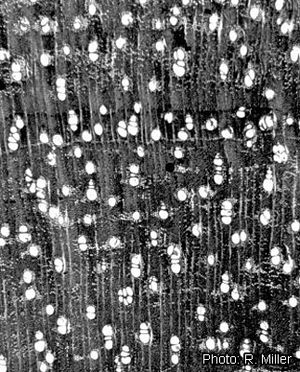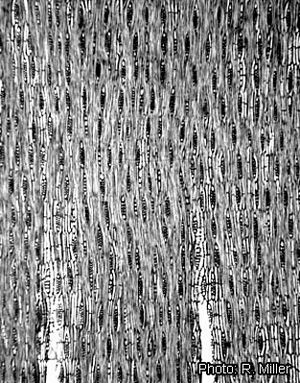Dalbergia nitidula (PROTA)
Introduction |
Dalbergia nitidula Baker
- Protologue: Oliv., Fl. trop. Afr. 2: 235 (1871).
- Family: Papilionaceae (Leguminosae - Papilionoideae, Fabaceae)
Vernacular names
- Glossy flat-bean, purplewood dalbergia (En).
Origin and geographic distribution
Dalbergia nitidula occurs from DR Congo and Uganda south to Angola, Zimbabwe, Mozambique and northern South Africa.
Uses
The wood is used in construction, especially for poles and pegs, and for combs, walking sticks, clubs and tool handles. It is usually only available in small pieces, which limits its applications. The wood is highly appreciated as firewood and for charcoal production.
In Tanzania chopped and cooked young leaves are used as a vegetable mixed with pounded groundnut. Leaves, roots and bark are used in traditional medicine in East and southern Africa. Chewed leaves are applied to snakebites and leaves are rubbed on abscesses. Warm water in which pounded roots have been soaked is gargled to treat toothache; root decoctions and infusions are taken for treatment of malaria and cough. The roots are also used to treat epilepsy. For this purpose they are pounded and administered in soup; they act as an emetic. In Zimbabwe the roots are taken as an aphrodisiac. Caution is needed because the roots are highly toxic. The bark is used as a wound dressing and to treat ulcers. The foliage is commonly browsed by cattle.
Properties
The heartwood is purplish brown. The density of the wood is about 780 kg/m³ at 0% moisture content. The wood is very durable and resistant to termite attack. The roots are toxic. Several isoflavonoids, isoflavonoid-neoflavonoid dimers, pterocarpan-neoflavonoid oligomers and rotenoid glycosides have been isolated from the bark and heartwood.
Description
- Deciduous shrub or small tree up to 12 m tall, often several-stemmed; bole up to 20 cm in diameter; bark surface silvery grey to greyish brown or reddish brown, becoming rough and fissured or flaking; crown open; young branches short-hairy.
- Leaves arranged spirally, imparipinnately compound with 9–15 leaflets; stipules 3–6 mm long, caducous; petiole and rachis short-hairy; petiolules 1–2 mm long; leaflets usually opposite, ovate to elliptical-oblong or broadly elliptical, 3–8.5 cm × 1.5–5 cm, leathery, usually densely hairy below.
- Inflorescence a congested panicle 1–5 cm long, several together at older nodes and ends of short lateral branches, hairy.
- Flowers bisexual, papilionaceous, (6–)7–10(–12) mm long; pedicel 1.5–5 mm long; calyx campanulate, 4–6 mm long, hairy, lobes shorter than tube, lower lobe longest, upper lobes fused; corolla whitish, with obovate standard and clawed wings and keel; stamens 10, in 2 groups of 5, fused into a tube, but free in upper part; ovary superior, with distinct stipe at base, style slender.
- Fruit a flat, elliptical to oblong, papery pod 4–7 cm × 1–1.5 cm, with stipe 8–10 mm long, usually glabrous, brown, laxly veined, indehiscent, 1–2(–3)-seeded.
- Seeds kidney-shaped.
Other botanical information
The roots of Dalbergia nitidula have nodules containing nitrogen-fixing bacteria. Trees grow slowly. They flower before or together with new flushes of leaves. The flowers are sweet scented and much visited by bees. The inflorescences are often replaced by dark, rounded galls, composed of numerous needle-shaped elements.
Dalbergia is a large pantropical genus comprising about 250 species. Tropical Asia and tropical America have about 70 species each, continental Africa about 50 and Madagascar slightly over 40.
Ecology
Dalbergia nitidula occurs in deciduous woodland, often in vegetation dominated by Brachystegia, also in thickets and wooded grassland, commonly on rocky hills and granite outcrops, at 300–1700 m altitude.
Management
Dalbergia nitidula is not cultivated and all useful products are collected from wild-growing trees. However, propagation by seed is easy. Pods should be collected soon after maturing to avoid damage by insects. They are broken into one-seed pieces (about 16,000 per kg) because extraction of seeds is difficult. These pieces are soaked in water for 6 hours before sowing. In general, germination is satisfactory and uniform. Seeds remain viable for a few months. Propagation by suckers is also possible. In Zambia trees showed good regrowth after coppicing. Recovery after partial bark removal was poor. Young leaves to be eaten as a vegetable are collected during the rainy season.
Genetic resources
There are no indications that Dalbergia nitidula is threatened by genetic erosion. It occurs widespread and is locally common.
Prospects
Trees of Dalbergia nitidula are too small sized to be of economic importance for their timber, but locally the wood is highly valued for small items because of its durability. Several interesting medicinal applications are known for Dalbergia nitidula, but little pharmacological research has been done and more research is warranted, especially concerning external applications on wounds, ulcers and abscesses. The safe use of the leaves as a vegetable and forage should be confirmed by phytochemical investigations and toxicity tests.
Major references
- Coates Palgrave, K., 1983. Trees of southern Africa. 2nd Edition. Struik Publishers, Cape Town, South Africa. 959 pp.
- Gillett, J.B., Polhill, R.M., Verdcourt, B., Schubert, B.G., Milne-Redhead, E., & Brummitt, R.K., 1971. Leguminosae (Parts 3–4), subfamily Papilionoideae (1–2). In: Milne-Redhead, E. & Polhill, R.M. (Editors). Flora of Tropical East Africa. Crown Agents for Oversea Governments and Administrations, London, United Kingdom. 1108 pp.
- Mbuya, L.P., Msanga, H.P., Ruffo, C.K., Birnie, A. & Tengnäs, B., 1994. Useful trees and shrubs for Tanzania: identification, propagation and management for agricultural and pastoral communities. Technical Handbook 6. Regional Soil Conservation Unit/SIDA, Nairobi, Kenya. 542 pp.
- Ruffo, C.K., Birnie, A. & Tengnäs, B., 2002. Edible wild plants of Tanzania. Technical Handbook No 27. Regional Land Management Unit/ SIDA, Nairobi, Kenya. 766 pp.
Other references
- Bekker, M., Malan, E., Steenkamp, J.A. & Brandt, E.V., 2002. An isoflavanoid-neoflavonoid and an O-methylated isoflavone from the heartwood of Dalbergia nitidula. Phytochemistry 59(4): 415–418.
- Ferreira, J.A., Nel, J.W., Brandt, E.V., Bezuidenhoudt, B.C.B. & Ferreira, D., 1995. Oligomeric isoflavonoids. Part 3. Daljanelins A-D, the first pterocarpan- and isoflavanoid-neoflavonoid analogs. Journal of the Chemical Society, Perkin Transactions 1: Organic and Bio-Organic Chemistry 1995(8): 1049–1956.
- Gelfand, M., Mavi, S., Drummond, R.B. & Ndemera, B., 1985. The traditional medical practitioner in Zimbabwe: his principles of practice and pharmacopoeia. Mambo Press, Gweru, Zimbabwe. 411 pp.
- Hauman, L., Cronquist, A., Boutique, R., Majot-Rochez, R., Duvigneaud, P., Robyns, W. & Wilczek, R., 1954. Papilionaceae (troisième partie). In: Robyns, W., Staner, P., Demaret, F., Germain, R., Gilbert, G., Hauman, L., Homès, M., Jurion, F., Lebrun, J., Vanden Abeele, M. & Boutique, R. (Editors). Flore du Congo belge et du Ruanda-Urundi. Spermatophytes. Volume 6. Institut National pour l’Étude Agronomique du Congo belge, Brussels, Belgium. 426 pp.
- Kokwaro, J.O., 1993. Medicinal plants of East Africa. 2nd Edition. Kenya Literature Bureau, Nairobi, Kenya. 401 pp.
- Moshi, M.J., Cosam, J.C., Mbwambo, Z.H., Kapingu, M. & Nkunya, M.H.H., 2004. Testing beyond ethnomedical claims: brine shrimp lethality of some Tanzanian plants. Pharmaceutical Biology 42(7): 547–551.
- Neuwinger, H.D., 2000. African traditional medicine: a dictionary of plant use and applications. Medpharm Scientific, Stuttgart, Germany. 589 pp.
- Palmer, E. & Pitman, N., 1972–1974. Trees of southern Africa, covering all known indigenous species in the Republic of South Africa, South-West Africa, Botswana, Lesotho and Swaziland. 3 volumes. Balkema, Cape Town, South Africa. 2235 pp.
- van Heerden, F.R., Brandt, E.V. & Roux, D.G., 1980. Synthesis of the pyranoisoflavonoid, heminitidulan; isoflavanoid and rotenoid glycosides from the bark of Dalbergia nitidula Welw. ex Bak. Journal of the Chemical Society, Perkin Transactions 1: Organic and Bio-Organic Chemistry 1980(11): 2463–2469.
- Williamson, J., 1955. Useful plants of Nyasaland. The Government Printer, Zomba, Nyasaland. 168 pp.
Author(s)
- R.H.M.J. Lemmens
PROTA Network Office Europe, Wageningen University, P.O. Box 341, 6700 AH Wageningen, Netherlands
Correct citation of this article
Lemmens, R.H.M.J., 2007. Dalbergia nitidula Welw. ex Baker. In: Louppe, D., Oteng-Amoako, A.A. & Brink, M. (Editors). PROTA (Plant Resources of Tropical Africa / Ressources végétales de l’Afrique tropicale), Wageningen, Netherlands. Accessed 5 April 2025.
- See the Prota4U database.


